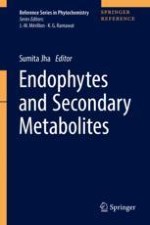2019 | OriginalPaper | Buchkapitel
18. Secondary Metabolites Produced by Endophytic Fungi from Marine Environments
verfasst von : Mishra Rashmi, J. S. Kushveer, V. Venkateswara Sarma
Erschienen in: Endophytes and Secondary Metabolites
Aktivieren Sie unsere intelligente Suche, um passende Fachinhalte oder Patente zu finden.
Wählen Sie Textabschnitte aus um mit Künstlicher Intelligenz passenden Patente zu finden. powered by
Markieren Sie Textabschnitte, um KI-gestützt weitere passende Inhalte zu finden. powered by
